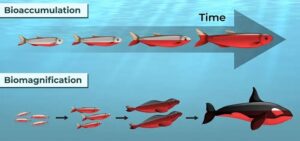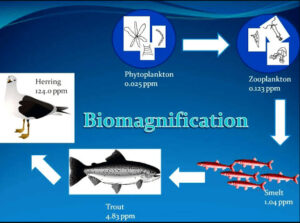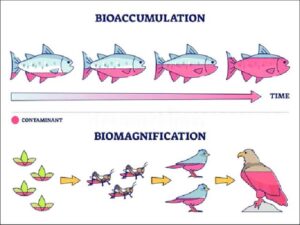Back to: Environmental Biology 400 Level
Welcome to class!
Imagine eating a fish from a polluted river, only to realise later that it contained dangerous chemicals stored up in its body. Now imagine that same fish was eaten by someone else, and the chemical concentration increased with every step up the food chain. That’s the reality of bioaccumulation and biomagnification. These two processes explain how toxic substances quietly build up in living organisms and can become more dangerous over time—especially in places where pollution is poorly managed.
Bioaccumulation And Biomagnification
What is Bioaccumulation?
Bioaccumulation refers to the gradual buildup of toxic substances, like heavy metals or pesticides, in the body of an organism over time. These substances enter the body faster than they can be broken down or excreted. For example, a tilapia fish living in a river contaminated with mercury will slowly absorb that mercury through water and food, storing it in its tissues.

What is Biomagnification?
Biomagnification is the increase in concentration of a toxic substance as it moves up the food chain. While bioaccumulation happens within one organism, biomagnification happens across several organisms. For instance, if small fish with mercury are eaten by bigger fish like catfish, and those catfish are then eaten by humans, the concentration of mercury increases at each level—posing greater health risks to those at the top of the food chain.
Key Pollutants That Bioaccumulate and Biomagnify
Heavy metals like lead, mercury, and cadmium
Persistent organic pollutants (POPs) like DDT and PCBs
Industrial chemicals and oil-based toxins

These substances don’t easily degrade in the environment. Once absorbed, they tend to remain in tissues—especially in fat or organs.
Examples from Nigeria
Mercury in Artisanal Gold Mining (Zamfara State):
Miners often use mercury to extract gold. Mercury vapour escapes into the air, while liquid mercury settles in soil and rivers. Aquatic organisms absorb it, leading to bioaccumulation and eventual biomagnification when consumed by humans.
Oil Spills in the Niger Delta:
Fish and shellfish in oil-polluted waters absorb hydrocarbons. Local communities that depend on these fish for food and trade suffer from long-term health effects, including neurological and reproductive issues.
Health and Environmental Impacts
In animals: reproductive failure, behavioural changes, and reduced survival
In humans: developmental problems, cancer, nervous system damage, and birth defects
In ecosystems: loss of biodiversity and collapse of aquatic food chains
Preventive Measures and Management
Proper industrial waste disposal and regulation

Ban or control of toxic pesticides and chemicals
Environmental monitoring of food and water sources
Public education on the risks of consuming contaminated organisms
Enforcing environmental protection laws, especially in pollution hotspots
Summary
- Bioaccumulation is the buildup of toxins in an organism over time.
- Biomagnification is the increase of toxin concentration across the food chain.
- Pollutants like mercury, lead, and POPs cause both processes.
- Nigerian examples include mercury from gold mining and oil pollution in the Niger Delta.
- Effects include health problems in humans and animals, and threats to ecosystems.
Evaluation
- Differentiate between bioaccumulation and biomagnification.
- List three pollutants that cause bioaccumulation.
- Describe one example of biomagnification in Nigeria.
- What are two health risks of consuming contaminated fish?
- Suggest two ways to prevent bioaccumulation in our environment.
You’re doing excellently! By understanding these environmental threats, you’re one step closer to becoming a change-maker in Nigeria’s ecological future. Keep it up—Afrilearn is proud to be on this journey with you.
